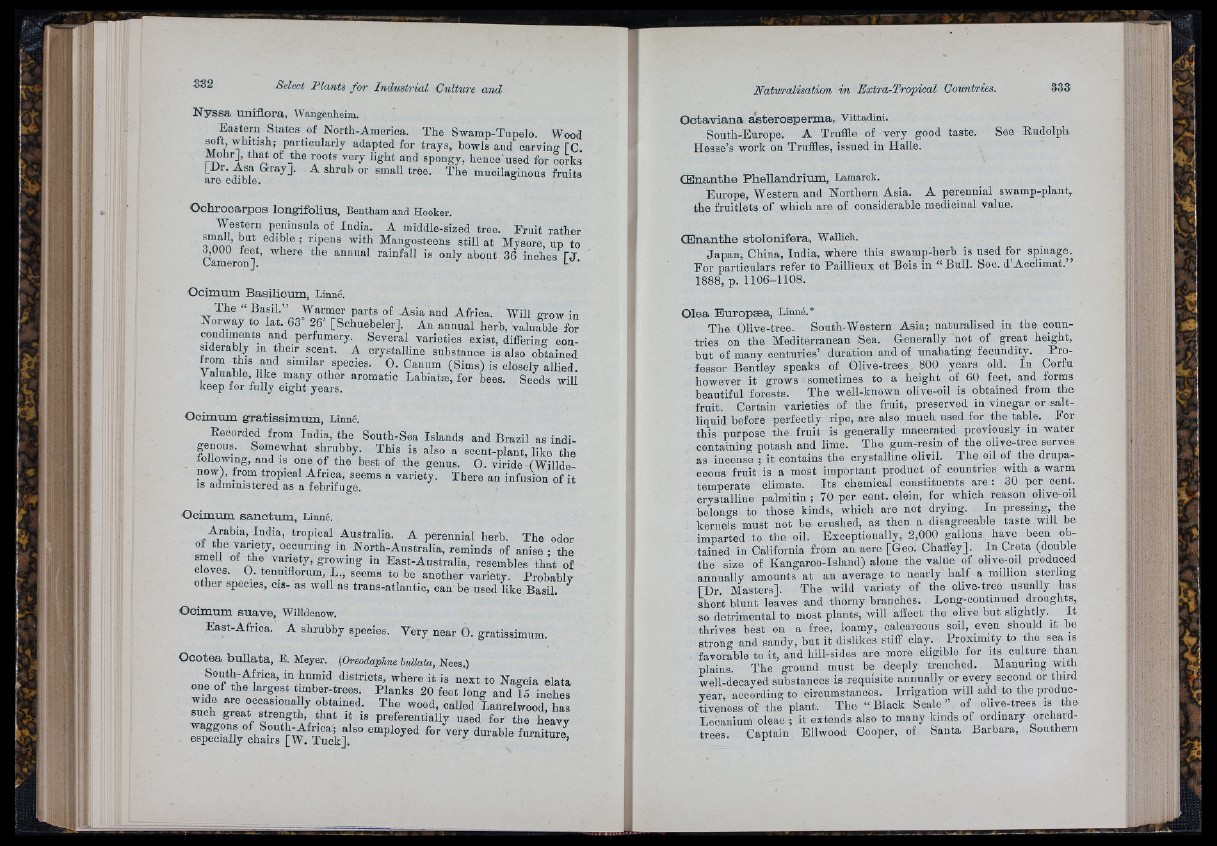
Ny ssa uniflora, Wangenheim.
Eastern States of North-America. The Swamp-Tupelo. Wood
soft, wlutish; particularly adapted for trays, bowls aud carving fC.
A ° 7® 1®°*® spo“ gy> hence'used for corks
[Dr. Asa Gray j. A shrub or small tree. The mucilaginous fruits
EirG 6Ulbl6.
Ochrocarpos long-ifolius, Bentham and Hooker.
Western peninsula of India. A middle-sized tree. Fruit rather
Tnnn 7 v- ® 4 ’ 7 ® “® Mangosteens still a t Mysore, up to
CamLon] ’® rainfall is only about 36 inches [ J .
Ocimum Basilicum, Linné.
The “ Basil.” Warmer parts of Asia and Africa. Will grow in
Norway to lat. 63° 26' [Schuebeler]. An annual herb, valuable for
condiments and perfumery. Several varieties exist, differing considerably
m their scent. A crystalline substance is also obtained
from this and similar species. O. Canum (Sims) is closely allied.
Vaiuahle like many other aromatic Labiatæ, for bees. Seeds will
keep for fully eight years.
Ocimum gratissimum, Linné.
Recorded from India, the South-Sea Islands and Brazil as indigenous.
Somewhat shrubby. This is also a scent-plaut, like the
following, and is one of the best of the genus. O. viride (Willdenow),
from tropical Africa, seems a variety. There an infusion of it
IS aamimstered as a febrifuge.
Ocimum sanctum, Linnc.
Arabia, India, tropical Australia. A perennial herb. The odor
ot the variety, occurring in North-Australia, reminds of anise ; the
smell of the variety, growing iu East-Australia, resembles th a t of
cloves, q . tenuiflorum, L., seems to be another variety. Probably
other species, cia- as well as trans-atlantic, can be used like Basil.
Ocimum suave, Willdenow.
East-Africa. A shrubby species. Very near O. gratissimum.
Ocotea bullata, E. Meyer. (Oreodaphne hutlata, Nees.)
n n f districts. Where it is next to Nageia elata
one of the largest timber-trees. Plan k s 20 feet long and 15 inches
wide are occasionally obtained. The wood, called Laurelwood, has
such great strength, th a t it is preferentially used for the heavy
Octaviana asterosperma, Vittadini.
South-Europe. A Truffle of very
Hesse’s work on Truffles, issued in Halle. g
ood taste. See Rudolph
OEnanthe Phellandrium, Lamarck.
Europe, Western and Northern Asia. A perennial swamp-plant,
the fruitlets of which are of considerable medicinal value.
CBnanthe stolonifera, Wallich.
Japan, China, India, where this swamp-herb is used for spinage.
For particulars refer to Paillieux et Bois in “ Bull. Soc. d Acclimat.
1888, p. 1106-1108.
Olea Europæa, Linné.*
The Olive-tree. South-Western Asia; naturalised in the countries
on the Mediterranean Sea. Generally not of great height,
hut of many centuries’ duration and of unabating fecundity. P ro fessor
Bentley speaks of Olive-trees 800 years old. In Corfu
however it grows sometimes to a height of 60 feet, and forms
beautiful forests. The well-known olive-oil is obtained from the
fruit. Certain varieties of the fruit, preserved in vinegar or salt-
liquid before perfectly ripe, are also much nsed for the table. For
this purpose the fruit is generally macerated previously in water
containing potash and lime. The gum-resin of the olive-tree serves
as incense ; it contains the crystalline olivil. 'The oil of the drupaceous
fruit is a most important product of countries with a warm
temperate climate. Its chemical constituents are : 30 per cent,
crystalline palmitin ; 70 per cent, olein, for which reason olive-oil
belongs to those kinds, which are not drying. In pressing, the
kernels must not be crushed, as then a disagreeable taste will he
imparted to the oil. Exceptionally, 2,000 gallons, have been obtained
in California from an acre [Geo. Chaffey]. In Creta (double
the size of Kangaroo-Island) alone the value of olive-oil produced
annually amounts a t an average to nearly h a lf a million sterling
[D r Masters]. The wild variety of the olive-tree usually has
short blunt leaves and thorny branches. Long-continued droughts,
so detrimental to most plants, will affect the olive but slightiy.^ I t
thrives best on a free, loamy, calcareous soil, even should it be
strong and sandy, but it dislikes stiff clay. Proximity to the sea is-
favorable to it, and hill-sides are more eligible for its culture than
plains. The ground must be deeply trenched. Manuring with
well-decayed substances is requisite annually or every second or third
year, according to circumstances. Irrigation will add to the productiveness
of the plant. The “ Black Scale” of olive-trees is the
Lecanium oleae ; it extends also to many kinds of ordinary orchard-
trees. Captain Ellwood Cooper, of Santa Barbara, Southern